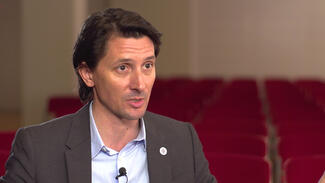
Gunter Dueck: Batterien & kalte Füße
Feststoffbatterien haben das Zeug, die Elektromobilität entscheidend nach vorne zu bringen. Doch deutsche Unternehmen scheuen das Risiko, in Zukunftstechnologien zu investieren. Aber vielleicht aus gutem Grund?
"Most companies see these technologies. They see the possibility of disruption but they don't know what to do about it."
Video abspielen
Langfristiges Denken ist in börsennotierten Unternehmen alles andere als eine Selbstverständlichkeit, wenn man ständig die Quartalsergebnisse im Blick haben muss. Rob Nail, Leiter des Thinktanks Singularity University in Mountain View (Kalifornien), erzählt, wie Harman und General Electric versucht haben, sich zukunftsfest aufzustellen. Zwei Unternehmen mit zwei ganz unterschiedlichen Geschichten.
Long term thinking is pretty unusual for companies on the public market when their entire focus is typically this quarter's earning statement. Rob Nail, CEO of Singularity University in Mountain View (California), explains how Harman and General Electric have tried to prepare their future business. Two companies and two different stories.
Beim Stifterverband im Video:
Die Zukunftsmacher und ihre Visionen für Bildung und Ausbildung, Forschung und Technik
Autor: Timur Diehn
Produktion: Webclip Medien Berlin
für den YouTube-Kanal des Stifterverbandes
One of the most difficult things that organisations have to deal with today is the ability to forecast the future. So deciding what direction to go requires a much more rigorous and intense process today than ever before.
Today with exponential technologies we see the conversions across different industries present the biggest threats and the biggest opportunities to a business, and unless there is a process or a mindset and the right people and the skillsets you completely miss what may be the most important element to your future business.
So when an organisation recognizes a shift in the future that's coming and they have the courage and vision to take a new path it's often met with scepticism and disbelief about that future being possible, that they are capable of transforming, and that it's even relevant in many cases.
So one of the things that we try to help organisations do first is have a perspective around technology and exponential technologies and then build in processes to constantly track and be aware of the trends, the potential opportunites and threats that are arising. But then also a process to forecast that exponential curve out on longer term horizons and build scenarios of possible future states, so both positive and negative. Then the organisation can plan towards going forward which is a little bit different. That long term thinking and strategic planning on those kinds of time horizons are pretty unusual for organisations or governments when our entire focus is typically this quarter's earning statement or you have a one-year plan or maybe a five-year plan.
Harman is largely an audio business but their biggest business unit is the infotainment system of automobiles and cars. So the computer systems, the navigation systems, the sound systems of vehicles. And with autonomous cars coming online that poses a major threat because the future of car is actually a computer system with wheels and other technologies versus the cars of today which are more the hardware and the steering systems with computers embedded in them, so it's a complete flip of the business. And so Harman had the vision of seeing what was coming, their forecast farther out is recognizing that autonomous cars are going to happen. Maybe not inevitably but pretty determined that that is going to be a major impact on the industry. And Harman's business is going to have to adapt dramatically if it wants to survive in that future business. So it ended up being an end-to-end transformation of the business, rebranding, restructuring, new businesses, new business units in cyber security, in information software that transforms what the company was like. And along the way we had to educate our investor base, our partners, our sales clients as to why we were transforming the business. And that vision for the autonomous future 3 or 4 years ago was, the rest of the industry was oblivious to that future. They had heard about the Google car, they had seen these things. But there was a disbelief that that future was going to be real. And the challenge for our business was that even if it's a low probability that that future could come to form it would have major consequences, in fact existential consequences on the business. And so it was worth the effort to transform because even if that didn't come to form the way that we saw it happening which it has already we'd at least be ahead of the game on the technology side and the software side, we'd at least be leading the industry relative to what everyone else is doing. So one of the challenges that I think I've seen at Singularity University working with many different companies is that most companies see these technologies. They see the possibility of disruption but they don't know what to do about it. Or they see a path but it's so difficult, and the CEO is so close to retirement that it doesn't make sense to do it. And in my experience with Harman seeing that the public market did not really reward us for that visionary innovation work I have to question whether the incentives are aligned in the public market system for long term resiliency. Because the public market is only rewarding short term gains as well. Big challenge! Now there are a few companies that are playing a different game. Amazon, Tesla for example. They are not competing, their investor base has bought on to the long term vision. They don't care about the short term returns, they bought on to the long term vision. The challenge is a company with 100 years of history has existing investors that you have to transform their mindset to get them on that future vision which is a really difficult task.
So my experience with Harman was that the vision that we had was so different than what our current investor base believed in that maybe the best path forward would be to go private and then go public again with a new investor base, with a new vision for what we are going to do going forward. That's a really difficult process for companies to endeavour. And if you look at other organisations, one of the most recent examples is GE. GE over the past 8 years put a lot of effort in transforming its business into a more digitized information based company. I believe a lot of the work that GE did built long term resiliency for that business. They actually did some of the fundamental work to allow them to exist for a much longer period of time into the future. They are a strong hardware business but it needs to be integrated with the data systems and information systems that they have basically built over the last several years. Unfortunately, the short term minded public market is not getting rewarded for that long term vision, and so they punish GE, and the CEO gets booted, and now the new CEO, his only incentive is around shareholder value which means he has no incentive to think long term. Big problem. This is a big problem. And so I believe the public market system has a distinct misalignment with long term thinking.
One of the challenges that Harman had was history. Harman had almost 100 years of history of the leading edge innovation around audio technologies, the first speakers for the talking movies, the first FM tuner, all these amazing technologies. And the business was largely built around those technologies, and so it ended in being a pretty vertically oriented business. So there was a consumer division that made headphones and audio receivers for the home. There was an auto business that largely focussed on infotainment and computer systems. There was a professional services business that focussed on bringing big industrial scale audio systems into conference halls and big buildings. And the challenge is when you started overlay information systems and data systems and digitize this business, it cuts across all of those different sectors. And so with Harman we ended up acquiring software services businesses, cyber security businesses, some other things that were very applicable to the different businesses. And we had to integrate and sort of restructure the entire business to think end-to-end solutions. No longer product-specific but solution-specific. And many companies go through this transformation but it is probably one of the hardest ones for an organisation to do in this effort to digitize because it does mean the products you sell, the skillsets you need, the people, the structure of how you organise and run the business, they are all slightly different. And that's a big effort for any organisation to undergo.